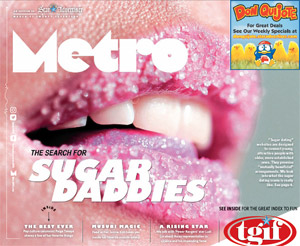Popular Exhibit Gets Extended Stay At Art Museum
If you haven’t seen Sean Connelly’s Land Division at Honolulu Museum of Art yet, you’re in luck — the display’s been extended through Jan. 4. But if you miss it, there’s no second chances: Connelly plans to turn his wooden sculpture into mulch and biochar.
“(Strawberry guava) is invasive, so the wood was brought out of the forest, which was good, but I would like it to somehow go back into a natural process of decomposition,” Connelly observes.
- Sean Connelly’s ‘Land Division’ is on display at Honolulu Museum of Art through Jan. 4 PHOTO BY SHUZO UEMOTO
- Sean Connelly (right) with curator Jay Jensen PHOTO COURTESY HONOLULU MUSEUM OF ART
It’s a fitting end for Land Division, but even as Connelly returns his sculpture to nature, he hopes he has inspired thought about the “land divisions” that exist today — the radically altered shape of the Hawaiian ahupuaa.
“The way we currently use land … and the way we create political boundaries are designed in a way that actually severs the connection of mountain to ocean,” Connelly explains. “For example, the mountains are zoned for conservation, but everything else to the sea is agricultural or urban; that actually, in a way, destroys the watershed.”
Kaneohe-born Connelly has always had watersheds and the land on his mind. His last exhibit was A Small Area of Land (Kakaako Earth Room) at ii Gallery in 2013, a 32,000-pound dirt-and-sand sculpture.
That attracted the attention of Honolulu Museum of Art curator Jay Jensen.
“Even though (Connelly) was trained as an architect, not an artist, I felt he just had the ability and talent to do something different,” Jensen muses.
He invited Connelly to participate in the museum’s ongoing feature of contemporary Hawaii-based artists. So Connelly dreamed up a 7-foot-tall structure made of strawberry guava trees from Kaneohe — a process of designing, sanding and building that took nearly three months and multiple teams of assistants to complete.
He wants his work to help people think critically about the way watersheds affect their lives.
“When you look at the mountains, they’re really beautiful, very green — but when you look closely, with a critical eye, you’ll notice a lot of the greenery is actually invasive species that are altering the ecology of the watershed.
“I’d like to build more awareness of these elements of our environment that generate and distribute freshwater.”
Connelly currently is attending grad school at Harvard University, where he’s focusing on “design through the economic perspective,” a multidisciplinary approach he hopes will benefit him as he looks toward reforming the land-use system into one more like the ahupuaa of old.
View Connelly’s ahupuaa research at hawaii-futures.com, and check out honolulumuseum.org for more about Land Division.



